
|
|

March 16, 2007
The Big Trip 2006, Part VI: Downtown Portland and KEX
Once every year or so, when finances and schedules permit, your editor and a couple of his similarly-obsessed radio pals get together to spend a week or so exploring a corner of our great nation, packing our schedules as full as possible to visit as many interesting broadcast facilities as we can.
And then, a few months later, once we've caught our breath (and some much-needed sleep), we share it all with you here on Tower Site of the Week (and in audio form over on Tophour.com) in a feature we call "The Big Trip."
The 2006 version of the Big Trip began and ended in Seattle, and along the way took us as far south as Eugene, Oregon and as far east as Coeur d'Alene, Idaho.
Day Four - Sunday, September 24
When we left off in the first part of our Portland visit last week, we were up in the Skyline Drive area, enjoying a guided tour (by Kent Randles, K7YXZ, senior engineer at Entercom Portland) of the city's big TV and FM tower sites. With that tour finished, and an hour or so remaining before we had to leave for our dinner appointment, we took advantage of having a local guide to see some more of the studio and tower sites in and around downtown Portland, beginning with a building that, though it hadn't housed a broadcast facility for a decade, was still at the top of our priority list.
Here's the point where, as promised, we divert briefly into an exploration of early Portland TV history, and in particular the history of the station that's now KPTV (Channel 12).
 KPTV
was a true pioneer: it was Portland's first TV station and the
nation's first commercial UHF station when it signed on September
20, 1952 on channel 27, ending the city's ignominious status
as the largest in the country with no local TV. (Portland spent
only a few months with that title, which had long been held by
Denver until the sign-on of KFEL-TV 2 there in July 1952.)
KPTV
was a true pioneer: it was Portland's first TV station and the
nation's first commercial UHF station when it signed on September
20, 1952 on channel 27, ending the city's ignominious status
as the largest in the country with no local TV. (Portland spent
only a few months with that title, which had long been held by
Denver until the sign-on of KFEL-TV 2 there in July 1952.)
Anyone interested in early TV should now carve out half an hour of free time and go visit the "Yesterday's KPTV" site, which was created in 2002 to pay tribute to KPTV's 50th anniversary; once there, you'll learn that KPTV was part of the Empire Coil Company (Herbert Mayer) family, along with WXEL in Cleveland and several other TV CPs over the years, and that the station made it to air (from the Council Crest Park tower we showed you last week) in just three weeks, with the aid of a UHF transmitter that had been in RCA's experimental use in Bridgeport, Connecticut, relaying WNBT programming from New York to demonstrate the feasibility of UHF television.
You'll learn, further, that KPTV enjoyed just over a year of TV monopoly in Portland, cherrypicking from all four networks, before KOIN-TV (Channel 6) came on in 1953 as the market's first VHF station and a primary CBS affiliate. KLOR-TV (Channel 12) was next on in 1955, grabbing ABC and leaving KPTV as a primary NBC affiliate for a year or so.
The advent of a third VHF station, KGW-TV (Channel 8), in 1956 sealed KPTV's fate up there on the UHF dial. KPTV (by then owned by Storer Broadcasting) briefly tried to get the FCC to allow it to move to channel 3 (later allocated to Salem, and ultimately moved to Bend). That didn't pan out, and in April 1957, George Haggerty bought both KPTV and KLOR, which had by then become an independent, with KGW taking the ABC affiliation.
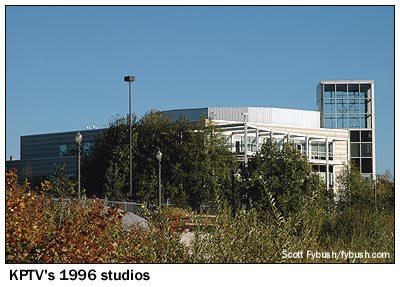 The
KLOR calls and most of its programming vanished from the dial,
and from the memory of most Portlanders, as KPTV assumed the
channel 12 dial position. It took KLOR's former transmitter at
Healy Heights (the eventual Stonehenge Tower site), abandoned
channel 27 and the Council Crest Park site, and kept the KPTV
studios at 753 SW 20th Place, just west of downtown Portland.
It's that building that you see on the front page of Yesterday's
KPTV, and it's that building (minus the big KPTV signs and the
garage on the left with a protruding live truck!) that you see
above, at left.
The
KLOR calls and most of its programming vanished from the dial,
and from the memory of most Portlanders, as KPTV assumed the
channel 12 dial position. It took KLOR's former transmitter at
Healy Heights (the eventual Stonehenge Tower site), abandoned
channel 27 and the Council Crest Park site, and kept the KPTV
studios at 753 SW 20th Place, just west of downtown Portland.
It's that building that you see on the front page of Yesterday's
KPTV, and it's that building (minus the big KPTV signs and the
garage on the left with a protruding live truck!) that you see
above, at left.
KPTV is long gone from there, after an action-packed history; after an affiliation swap with KGW made KPTV an ABC affiliate in 1959, the debut of KATU (Channel 2) in 1962 soon turned KPTV into an independent. It became a charter Fox affiliate in the mid-80s, but after disputes about carrying low-rated weekend Fox offerings (this was decidedly pre-Simpsons and pre-NFL!), KPTV went back to independent status in 1988. In 1995, it joined UPN, and in 1996, it left SW 20th Place after 43 years, building a fancy new studio at 211 SE Carruthers, on the east bank of the Willamette River south of downtown. That's the building you see at right - but KPTV's not there, either, and neither is the huge neon "12" sign that was in the glass tower along the river. (You can see that on the "Yesterday's KPTV" site, too.)
In 2000, Chris-Craft (which had owned KPTV since 1960) was sold to Fox, but KPTV didn't come along for the ride, getting traded to Meredith in exchange for WOFL in Orlando. Meredith already owned Fox affiliate KPDX (Channel 49) in the market, and in 2002 it moved Fox back to KPTV, consolidated the two stations' rival news operations, and moved KPTV out to the KPDX studios in Beaverton, which we saw last week. (KPDX would eventually migrate from UPN to My Network TV, and today brands itself as "PDX49," wisely eschewing much on-air mention of that struggling mini-network.)
So now you know why we were so interested in seeing the SW 20th Place building, which still (to us, anyway) carries some of that exciting whiff of anything-goes early local TV, however much it's been renovated in the interim.
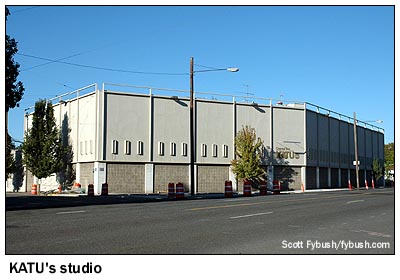 (Oh
- one last thread to tie up here: after KPTV merged with KLOR
and left channel 27 vacant, a new station, KHTV, briefly tried
its hand at UHF, transmitting from the 4636 SW Council Crest
Drive site we looked at last week.
(Oh
- one last thread to tie up here: after KPTV merged with KLOR
and left channel 27 vacant, a new station, KHTV, briefly tried
its hand at UHF, transmitting from the 4636 SW Council Crest
Drive site we looked at last week.
It lasted only a few months in 1959 before itself going dark, and channel 27 remained vacant in Portland for many decades thereafter...until Oregon Public Broadcasting's KOPB-TV, channel 10, secured 27 as its DTV channel. Wonder if anyone there appreciates the historic connection? It won't last long, in any event; KOPB will return to 10 as its permanent DTV channel in 2009, taking channel 27 dark again almost exactly half a century after KHTV went away.)
From here, our little tour goes across the river to Portland's newest VHF station.
KATU (Channel 2) didn't make it on the air until 1962, but it's been awfully stable ever since: it's been right here at 2153 NE Sandy Boulevard under Fisher Communications ownership from the beginning, and it's been an ABC affiliate since 1964, when it grabbed the affiliation from KPTV.
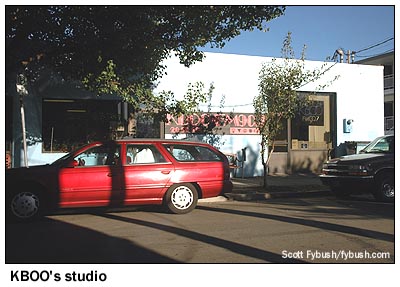
|
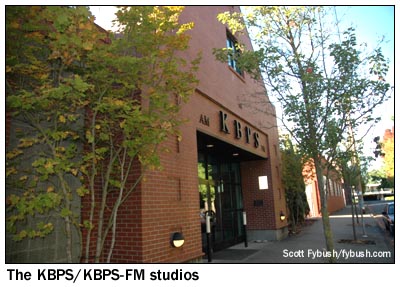
|
KATU was also one of Bill O'Reilly's many stops in local TV during his long, slow rise to national fame, though one suspects Bill'O doesn't have too many fans at the next stop on our little east-of-the-river driving tour.
Just off East Burnside Street, the main drag through the neighborhood (it, and Sandy Boulevard, both make up part of US 30 through the east side of Portland), community station KBOO (90.7) has its studios in a little building at 20 SE 8th Avenue.
KBOO was one of Lorenzo Milam's network of community radio stations from back in the sixties and seventies, and while it began as an offshoot of Seattle's KRAB (yes, they called the loose network of stations the "KRAB Nebula"), it outlived its former parent station, which ended up being sold and going commercial. KBOO ended up increasing power from its original 10 watts to today's C1 status from the Stonehenge Tower, and today it offers a wide variety of programming from inside this little building.
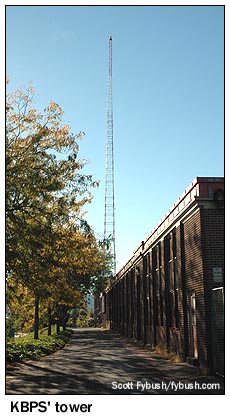
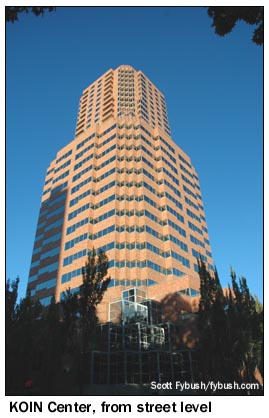 Kent
also drives us by the former home of KPDX, when it was a scrappy
little independent in the late 80s (I believe that was on Martin
Luther King Jr. Boulevard), and this is also the point where
we check out the 1996 KPTV studios, just south of the Oregon
Museum of Science and Industry and not far from the Ross Island
Bridge over the Willamette.
Kent
also drives us by the former home of KPDX, when it was a scrappy
little independent in the late 80s (I believe that was on Martin
Luther King Jr. Boulevard), and this is also the point where
we check out the 1996 KPTV studios, just south of the Oregon
Museum of Science and Industry and not far from the Ross Island
Bridge over the Willamette.
The map shows me now that the KLOR studios, during its brief 1955-57 run, were at 915 NE Davis, just a few blocks from KBOO's current home, but I suspect little is left of the place half a century after the fact. (I've since been told, by the good folks over at pdxradio.com, that the KLOR building is in fact still there - one more reason to make a return trip to Portland!)
There's one more significant stop to make on the east side before our tour with Kent is over: Benson Polytechnic High School sits on a nine-acre campus just south of I-84 on NE 12th Avenue, and it has a long, proud broadcasting history. KFIF signed on here in 1923 as one of the first high-school stations in the country, and under new calls KBPS ("Benson Polytechnic School"), it's been part of the Portland Public School District's communications program ever since.
There's a KBPS studio building on the east side of the campus, facing NE 15th Avenue, and while it proclaims both "AM" and "FM" on the facade, there's little connection between KBPS (1450) and KBPS-FM (89.9) these days. The AM side remains licensed to the school district, with its transmitter right there on the Benson campus and its studios in the school. During the day, students run the station as part of the educational program, with a format aimed at kids (think Radio Disney without all the Disney promos), and at night, the airtime is leased out to Portland State University's campus station, "KPSU," which also has a fulltime webcast and a low-power campus FM presence on 98.3. KBPS-FM, meanwhile, operates from the 15th Avenue building, with transmitter at Sylvan, and it's now owned by the KBPS Public Radio Foundation, which programs an all-classical format there.
With deep thanks to Kent for his tour-guide services, we say our farewells at this point and make our way downtown for one more tour before dinner: KOIN (Channel 6) occupies part of one of the most distinctive parts of the Portland skyline. In 1984, KOIN sold the land under its former studios at 222 SW Columbia, on the southern edge of downtown, for the construction of the 509' skyscraper now known as the KOIN Center.
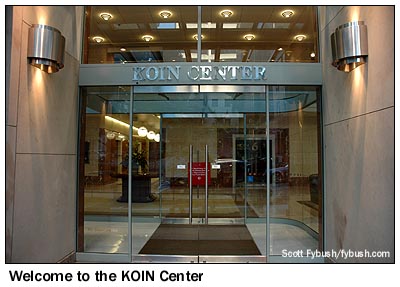
|
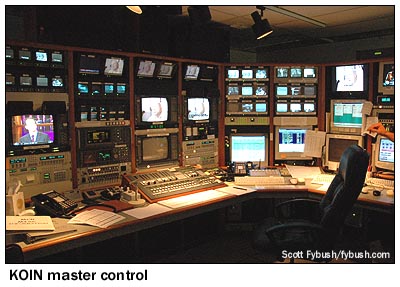
|
KOIN itself remained in the building, with a small lobby just behind the main entrance to the building (those are the doors just to the right of the elevator bank in the photo above), and most of its facilities on three floors below street level. We get to see them this Sunday evening thanks to a fellow Rochesterian, KOIN chief meteorologist Jeff Baskin, who just happens to be a childhood friend of your editor. (And the Rochester connection continues: weekend anchor Ken Boddie, seen at left in the photo below, also got his start in upstate New York, working at WHCU in Ithaca and WDKX in Rochester.)
The main air studio and newsroom are next to each other, way down at the bottom of the building, as it were, and the absence of windows is somewhat made up by those nice high ceilings and plenty of space, somewhat unusual in a newsroom these days.
Though we don't see them on this visit, there are radio stations in the KOIN Center as well: CBS Radio now owns the former KOIN(AM), now KCMD (970), and it shared space with sister stations KUPL-FM 98.7 and KLTH 106.7 on the second floor of the tower until moving out in February. (KUPL and KLTH are still there.)
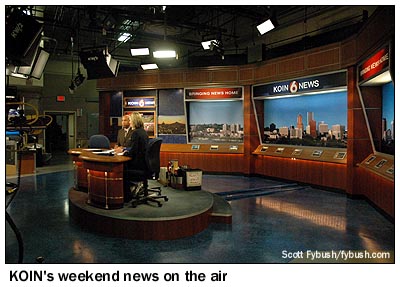
|
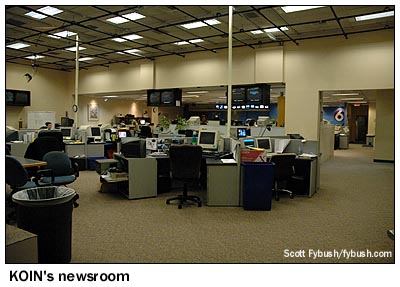
|
After our tour, we walk a few blocks east to the river and enjoy a darned fine seafood dinner while hearing Jeff's amazing tale of his arrival at KOIN: he had been working at then-Emmis sister station WVUE in New Orleans, and he accepted the KOIN job in August 2005. He was just getting ready to leave New Orleans when Katrina hit, and after riding out the storm's arrival, he escaped first to Houston, then to Portland, with nothing but a small bag of clothes. Upon arrival at KOIN, he became the story for a while, and while things have quieted down for him since then, it's still an emotional story for us to hear, and for him to share.
After dinner, we say our farewells to Jeff, head to the other side of downtown to check out the fantastic Powell's City of Books, one of the nation's foremost independent booksellers, and finally call it a night.
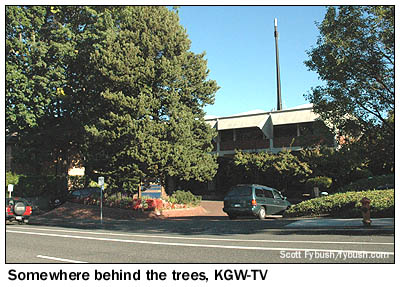
|
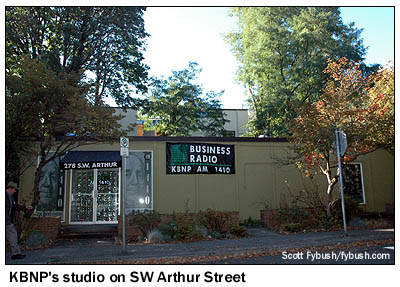
|
Day Five - Monday, September 25
What were the odds that every day we spent in Oregon would be warm and blue-sky sunny? Dunno...but that's the way our luck held, as our final day in the Beaver State again dawned bright and clear and our little group gathered to head out for a few more hours of Portland before heading east.
Departing our downtown hotel, we drive by the KGW-TV studios at 1501 SW Jefferson, right near I-405 on the west edge of downtown. (These TV studios, too, continue to house radio facilities that are no longer related; former KGW sister station KINK 101.9 continues to rent space here, many years after King Broadcasting sold both radio and TV. KGW-TV is now part of Belo, while KINK is part of CBS Radio.)
Another big cluster of radio and TV studios sits south of downtown, right back where we started our Portland visits at Entercom on SW Bancroft. The remaining CBS stations (KUFO 101.1, KVMX 107.5 and now KCMD) are on SW 1st Avenue, and a few blocks to the south, just across the tangle of highway where I-405 merges into I-5, business radio KBNP (1410) has a little building at 278 SW Arthur.
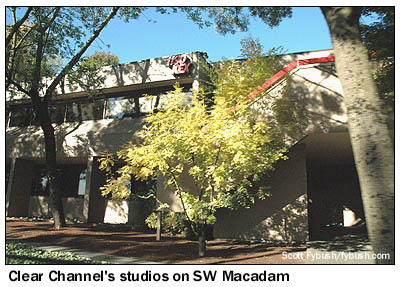
|
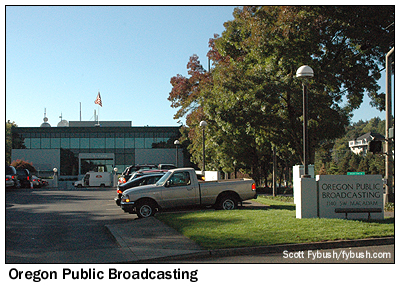
|
Even closer to Entercom on SW Bancroft, Macadam Avenue is home to a few more big broadcast facilities. At 4949 SW Macadam is the studio and office building KEX (1190) and KQFM (100.3, now KKRZ) built in the late seventies, which today is home to all of Clear Channel's Portland stations, including progressive talk KPOJ (620), AC "K-103" KKCW (103.3) and smooth jazz KIJZ (105.9).
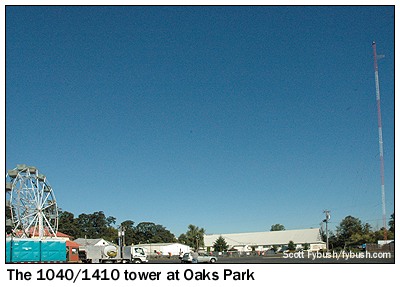 Down
the street at 7140 SW Macadam is the broadcast center for Oregon
Public Broadcasting's statewide radio and TV networks. And just
past that is the Sellwood Bridge, which takes us east of the
Willamette one final time and over to Oaks Park, right down by
the river.
Down
the street at 7140 SW Macadam is the broadcast center for Oregon
Public Broadcasting's statewide radio and TV networks. And just
past that is the Sellwood Bridge, which takes us east of the
Willamette one final time and over to Oaks Park, right down by
the river.
Oaks Park is both an amusement park and a venerable transmitter site: it was home, back in the thirties, to KWJJ on its original frequency of 1040. In 1948, KWJJ, by then on 1080, moved its transmitter north to Smith Lake, just south of the Columbia River. (We'll catch up with it again later on in our travels), and the next year, Oaks Park became home to KLIQ (1290), which would become the longest-running tenant here. KLIQ eventually changed city of license to Lake Oswego moved south and east to the 1520 Oregon City (then KYXI, now KGDD) site, before finally going dark a couple of years ago in favor of a new expanded-band AM, KDZR (1640) - and we'll catch up with that one, too, later on.
Meanwhile, the construction of the Stonehenge tower in 1990 displaced the station on 1410, which had gone from KPAM to KCNR to KKUL to KBNP over the years, and it ended up at Oaks Park, where it remains today, as KBNP, with 5000 watts by day and 9 watts at night. Another brand-new AM arrived here in 1993, licensed to Tigard and operating, ironically enough, on the same 1040 frequency that started it all back in the thirties: KEZF became KLVP, was owned for a while by the "K-Love" folks, and is now regional Mexican as KXPD.
From here, we zip south and east through Milwaukie and across I-205 to SE Lawnfield Road and the most powerful transmitter site in Portland, not to mention perhaps the most historic one still standing. If you've only ever heard of one Portland radio station, this is probably the one: 50,000-watt KEX (1190).
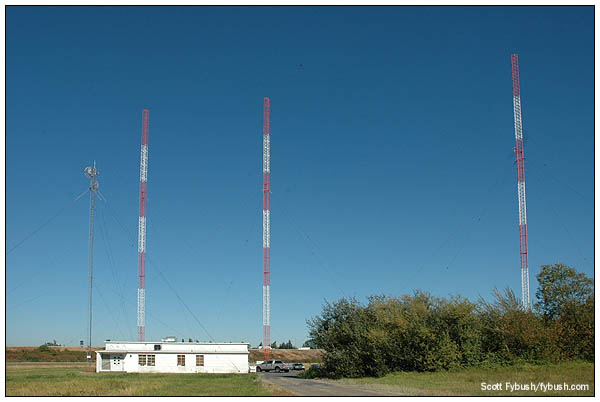
When KEX arrived at this site in 1948, it was already an established player in Portland radio, having been founded in 1926. In 1933, it became a sister station to the Portland Oregonian's KGW (620), and in 1935 it began sharing a transmitter site on North Denver Avenue, just south of the Interstate Bridge, with KGW. KEX moved about the dial, going from 1180 (where it was sharing nights with KOB in Albuquerque) to 1160 in 1939, to 1190 in 1941, protecting (and being protected by) WOWO in Fort Wayne. The FCC's mandated end to local radio duopoly forced a 1944 sale to Westinghouse, which just happened to also own WOWO, and once the war was over, KEX powered up from 5 kW to 50 kW DA-1, inaugurating this new site with its three 455-foot Blaw-Knox towers and, of course, a Westinghouse 50-HG transmitter.
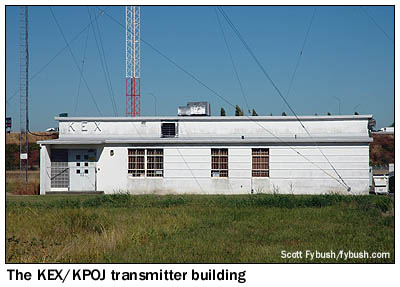
|
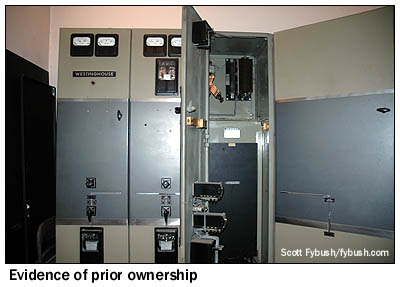
|
Today, as KEX chief engineer Chris Weiss gives us a tour of the place, there's not much to be seen of the Westinghouse days. Westinghouse sold KEX in 1962, I believe in order to stay under the ownership limits when it acquired WINS in New York, and the 50HG has long since given way to a Continental 317, which in turn is now a backup to a Harris DX50. Today, only the electrical panel on the front wall shows evidence of the old days.
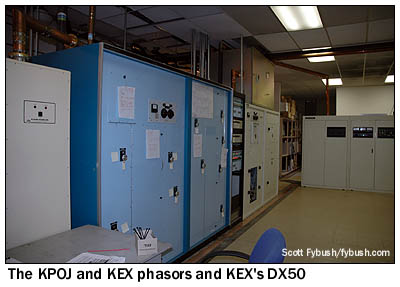
|
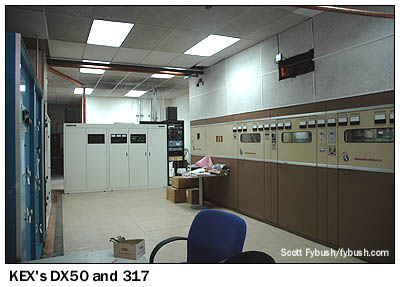
|
In the meantime, there's another station here now: in 2000, the former KGW (620), by then having gone through a series of new calls (KINK, KOTK, KEWS, KDBZ), lost its longtime Vanport transmitter site near the Columbia River - the same site that it shared with KEX in the thirties and forties. The old site was purchased by the Port of Portland and returned to wetlands to mitigate new construction at Portland International Airport, its history preserved at the radiotowersite.com website (including video of the two 625' towers coming down, and pictures of the transmitter building, which survived the devastating 1948 Vanport flood that took down one of the towers) - and 620 ended up once again sharing a site with KEX, this time out here in Clackamas.
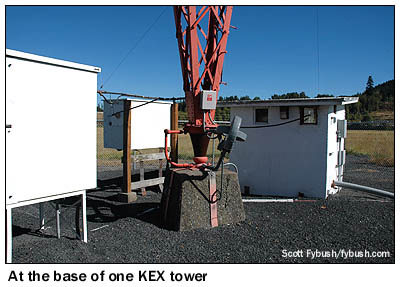
|
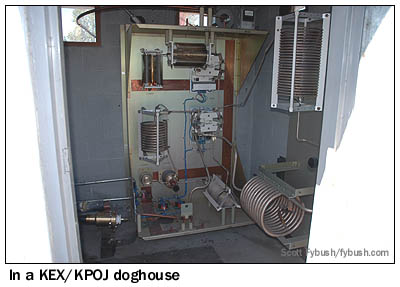
|
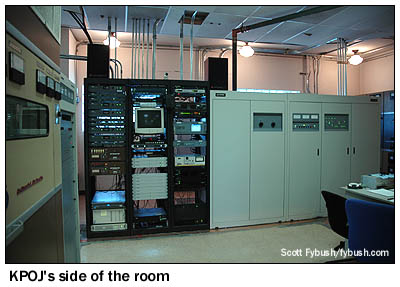 Two
more call changes (to KTLK, then KPOJ), one power increase and
one successful format change (to progressive talk) later, 620
now uses 25 kW by day and 10 kW at night, using the outer two
towers daytime (while KEX uses the center tower for its signal,
which went to 50 kW nondirectional by day in the nineties) and
the center and east towers at night. There's a Harris DX25U transmitter
at one end of the KEX transmitter room for KPOJ now, and new
ATUs at the base of each of the towers for diplexing the two
big signals.
Two
more call changes (to KTLK, then KPOJ), one power increase and
one successful format change (to progressive talk) later, 620
now uses 25 kW by day and 10 kW at night, using the outer two
towers daytime (while KEX uses the center tower for its signal,
which went to 50 kW nondirectional by day in the nineties) and
the center and east towers at night. There's a Harris DX25U transmitter
at one end of the KEX transmitter room for KPOJ now, and new
ATUs at the base of each of the towers for diplexing the two
big signals.
(KPOJ, incidentally, uses the callsign of the old Oregon Journal station on 1330, which is kind of ironic, inasmuch as 620 was the rival Oregonian's station for many years; we'll see what happened to the old KPOJ next week.)
On our to-do list, sometime soon, is to follow up on CE Chris Weiss' suggestion that we get in touch with the family that's been maintaining these towers ever since their very first paint job way back in 1948 - we'll have to do that, and share more of this site's history in a future segment, maybe around the time it's featured in a future Tower Site Calendar.
It's almost time for lunch as we say our farewells to Chris and head off to rejoin Kent for a few more Portland sites before we head out of town. Join us right back here for our next installment, in which we see more of the AM sites on Portland's east side, then make our way east along the scenic Columbia River Gorge - and visit Tophour.com beginning Wednesday, March 21 to hear more of the legal IDs of greater Portland!
 The
Tower Site Calendar 2007 is here! They're about to sell out,
just like 2006 did - order today at the Fybush.com
Store!
The
Tower Site Calendar 2007 is here! They're about to sell out,
just like 2006 did - order today at the Fybush.com
Store!
- Previous Site of the Week: Portland, Oregon's West Side TV/FM Towers
- Next Week: More Portland, plus Hood River and The Dalles, Oregon
- Site of the Week INDEX!
- How can you help support Site of the Week? Click here!
- Submit your suggestions for a future Site of the Week!
